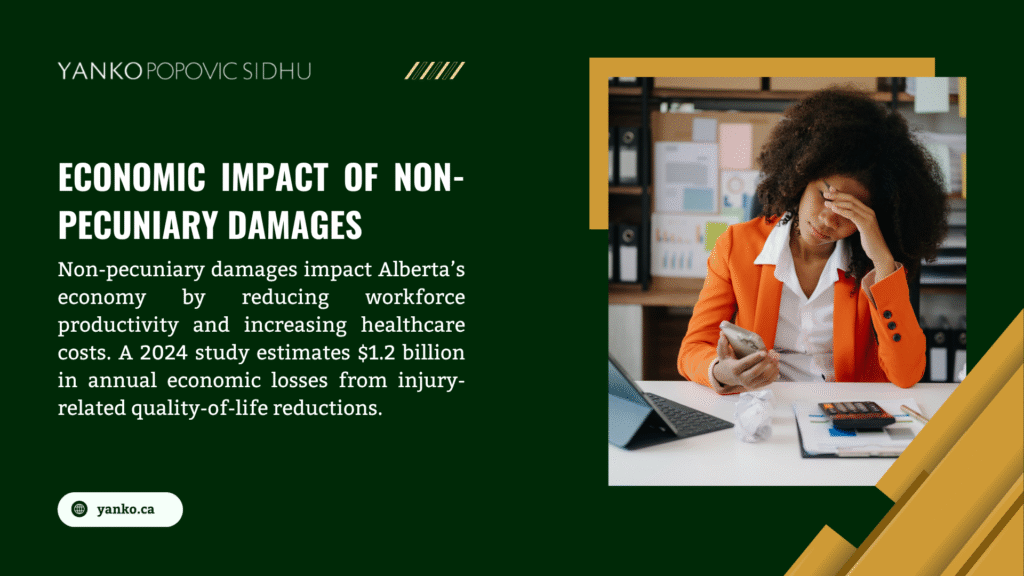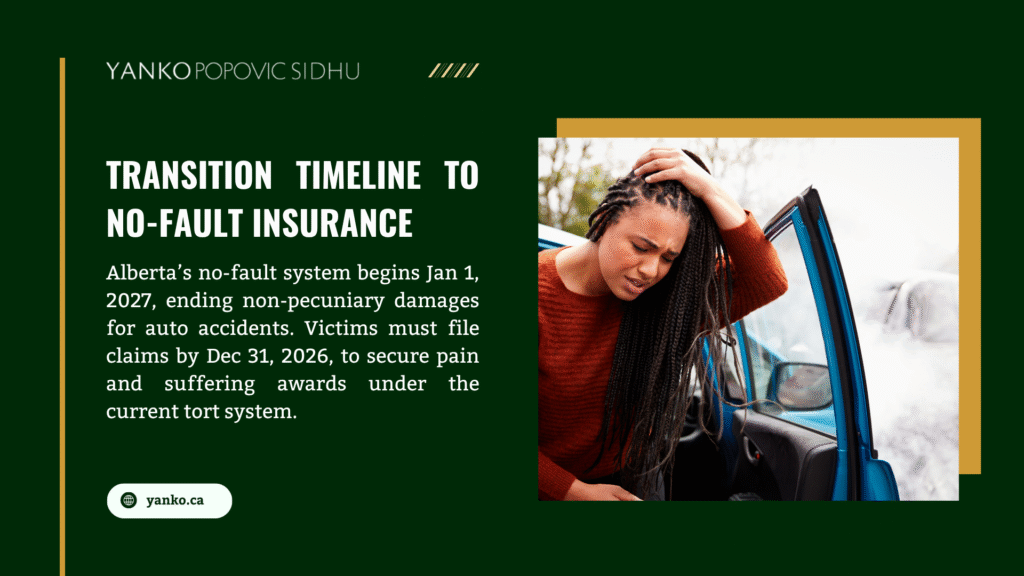Article Summary
This article examines non-pecuniary damages in Alberta’s personal injury framework, covering the current $465,000-$470,000 Supreme Court cap, the $6,182 minor injury limit for 2025, and the upcoming 2027 no-fault insurance transition. We analyze calculation methods across injury severities, factors affecting award amounts, and recent settlement trends from $2,500 to $1.6+ million. The guide includes typical compensation ranges by injury type, judicial assessment standards, and strategic approaches for maximizing non-pecuniary damage awards before Alberta’s significant 2027 system changes.
What Are Non-Pecuniary Damages in Alberta Personal Injury Claims?
Non pecuniary damages represent compensation for intangible losses that cannot be precisely measured in monetary terms following an injury. Unlike economic damages that cover quantifiable losses like medical expenses and lost income, non pecuniary damages address subjective impacts that fundamentally alter the quality of life.
In Alberta’s legal framework, non-pecuniary damages compensate for:
| Non-Pecuniary Damage Category | Description | Examples |
| Pain and Suffering | Physical discomfort and emotional distress | Chronic pain, depression, anxiety |
| Loss of Enjoyment of Life | Inability to participate in activities previously enjoyed | Sports limitations, hobby restrictions |
| Loss of Amenities | Reduced capacity to engage in daily activities | Difficulty with personal care, household tasks |
| Reduced Life Expectancy | Shortened lifespan due to injuries | Terminal conditions, reduced longevity |
| Psychological Impacts | Mental health consequences | PTSD, mood disorders, sleep disturbances |
These losses lack precise dollar values but significantly impact victims’ lives. Alberta courts apply standardized approaches to non pecuniary damages while acknowledging each case’s unique circumstances, creating a balance between consistency and individualized justice.
Alberta’s Dual Cap System for Non Pecuniary Damages
Alberta operates under a two-tiered cap system that establishes maximum limits on non pecuniary damages based on injury severity and classification.
Supreme Court Cap for Catastrophic Injuries
For the most severe injuries like quadriplegia or severe brain damage, non pecuniary damages reach approximately $465,000 to $470,000. This cap, derived from the Supreme Court of Canada trilogy decisions, adjusts annually for inflation from the original $100,000 established in 1978.
The Supreme Court trilogy cases—Andrews v. Grand & Toy Alberta Ltd., Arnold v. Teno, and Thornton v. School District No. 57—established this upper limit to prevent excessive awards while ensuring serious injuries receive substantial compensation.
Minor Injury Regulation Cap
For minor injuries, particularly from motor vehicle accidents, Alberta imposes a statutory cap that increased to $6,182 for 2025, up from $6,061 in 2024. This 2% annual adjustment affects soft tissue injuries, including whiplash, sprains, and strains, along with any associated psychological effects that don’t result in serious impairment.
The minor injury definition expanded in 2020 to capture more psychological sequelae, limiting recovery for many motor vehicle accident victims. This regulation creates a strict boundary for what many consider substantial injuries with lasting impacts.
| Year | Minor Injury Cap | Annual Increase |
| 2025 | $6,182 | 2.0% |
| 2024 | $6,061 | 2.0% |
| 2023 | $5,942 | 2.5% |
| 2022 | $5,798 | 4.8% |
| 2021 | $5,532 | 4.2% |
| 2020 | $5,308 | 3.2% |
| 2019 | $5,146 | 1.3% |
| 2018 | $5,080 | 1.2% |
The annual adjustments reflect Alberta’s Consumer Price Index changes, creating gradual increases that maintain the cap’s restrictive effect on minor injury compensation.
Recent Non Pecuniary Damages Awards in Alberta Cases
Alberta courts have established clear patterns in non pecuniary damages awards based on injury severity and long-term impacts. Recent cases provide insight into current judicial approaches.
Catastrophic Injury Non Pecuniary Awards
High-value catastrophic settlements dominate recent Calgary personal injury outcomes. A 2024 traumatic brain injury case achieved over $1.6 million in total compensation, with non pecuniary damages approaching the Supreme Court cap. This case involved skull fractures, jaw fractures, multiple rib fractures, and punctured lungs – demonstrating how severe, permanent injuries command maximum compensation.
In another notable case, a pedestrian collision resulting in severe multiple trauma with permanent loss of mobility received $1.15 million, with substantial non pecuniary damages reflecting life-altering impacts.
These settlements illustrate how catastrophic injuries with permanent disabilities typically receive non pecuniary damages near the Supreme Court cap of $465,000-$470,000.
Moderate Injury Non Pecuniary Awards
Moderate injury settlements typically range from $200,000 to $600,000 in total compensation. A young adult with mild traumatic brain injury affecting work capacity received $538,191, while TMJ and spinal injury cases settled for $421,000. Even seemingly minor cases involving teenagers can reach substantial amounts – a 16-year-old student with two broken bones and bilateral TMJ disorder received $189,398.
Non pecuniary damages within these moderate cases typically range from $50,000 to $125,000, reflecting significant but non-catastrophic impacts on quality of life.
Minor Injury Non Pecuniary Awards
For injuries falling under the Minor Injury Regulation, non pecuniary damages cannot exceed the statutory cap regardless of subjective impact. Soft tissue injuries typically settle for $2,500 to $10,000 in total compensation, with non pecuniary damages limited to the current $6,182 cap.
| Injury Severity | Total Settlement Range | Non Pecuniary Component |
| Catastrophic | $800,000 – $1.6+ million | $400,000 – $470,000 |
| Severe | $600,000 – $800,000 | $125,000 – $400,000 |
| Moderate | $200,000 – $600,000 | $50,000 – $125,000 |
| Minor (Non-Cap) | $10,000 – $200,000 | $10,000 – $50,000 |
| Minor (Cap) | $2,500 – $10,000 | Up to $6,182 (2025) |
How Alberta Courts Calculate Non Pecuniary Damages
Alberta courts employ a multifaceted approach to calculating non-pecuniary damages that considers both objective and subjective factors. The process balances precedent with individual circumstances.
Judicial Assessment Factors
Courts evaluate several key factors when determining non pecuniary damages:
| Assessment Factor | Judicial Consideration | Impact on Award |
| Age | Younger victims face longer periods of suffering | Higher awards for younger victims |
| Severity | Degree of pain and physical limitation | Direct correlation with the award amount |
| Duration | Temporary vs. permanent conditions | Permanent conditions receive higher awards |
| Lifestyle Impact | Pre-injury activities now limited | Greater lifestyle changes increase awards |
| Psychological Effects | Mental health consequences | Documented conditions increase awards |
| Medical Prognosis | Future improvement possibilities | Poor prognosis increases awards |
| Victim Credibility | Consistent testimony and medical support | Critical for maximum awards |
Non Pecuniary Damages Calculation Methods
Alberta courts typically employ three main approaches to calculate non pecuniary damages:
- Functional Approach: Examines specific functional losses and assigns values to each impacted area of life
- Conceptual Approach: Considers the global impact on quality of life rather than isolated functional losses
- Comparative Approach: References similar cases and award amounts to maintain consistency
Most judicial decisions incorporate elements from all three approaches while emphasizing the unique aspects of each case. This balanced methodology maintains fairness while acknowledging individual circumstances.
Non Pecuniary Damages by Specific Injury Types
Award patterns emerge when examining non pecuniary damages across different injury categories, providing useful reference points for case valuation.
Traumatic Brain Injury Non Pecuniary Damages
Traumatic brain injuries command some of Alberta’s highest non pecuniary damages. A 2024 case involving skull fractures and significant cognitive impairment received total compensation exceeding $1.6 million, with non pecuniary damages approaching the Supreme Court maximum.
Non pecuniary damages for TBI cases typically follow this pattern:
| TBI Severity | Non Pecuniary Range | Key Factors |
| Severe | $350,000 – $470,000 | Permanent cognitive disability, personality changes |
| Moderate | $125,000 – $350,000 | Ongoing cognitive issues with some adaptation |
| Mild | $50,000 – $125,000 | Recovery with residual symptoms |
| Minor | Up to $50,000 | Full or substantial recovery expected |
Traumatic brain injuries often qualify for the highest non pecuniary damages due to their profound impact on identity, relationships, and cognitive function. For specialized legal assistance with brain injury cases, contact a brain injury lawyer who understands the complexities of these claims.

Spinal Cord Injury Non Pecuniary Damages
Spinal injuries represent another category commanding substantial non pecuniary damages due to mobility limitations and chronic pain.
| Spinal Injury Type | Non Pecuniary Range | Functional Impact |
| Quadriplegia | $400,000 – $470,000 | Complete loss of limb function |
| Paraplegia | $300,000 – $400,000 | Lower body paralysis |
| Incomplete SCI | $100,000 – $300,000 | Partial function with limitations |
| Disc Herniation | $50,000 – $150,000 | Pain with activity restrictions |
| Whiplash (Chronic) | $10,000 – $50,000 | Ongoing pain beyond cap exemption |
| Whiplash (Minor) | Up to $6,182 | Falls under Minor Injury Regulation |
Spinal injuries command $250,000 to $500,000+ in total compensation, with non pecuniary damages forming a substantial portion of these awards. For dedicated representation in these complex cases, consult a spinal cord injury lawyer with specialized expertise.
Fracture and Orthopedic Injury Non Pecuniary Damages
Fractures range from $15,000 for simple breaks to $500,000+ for complex surgical cases in total compensation. Non pecuniary damages within these ranges vary based on recovery trajectory and permanent limitations.
| Fracture Type | Non Pecuniary Range | Recovery Considerations |
| Multiple Complex Fractures | $75,000 – $200,000 | Surgical intervention, permanent hardware |
| Pelvic/Hip Fractures | $50,000 – $150,000 | Mobility impacts, lengthy recovery |
| Leg/Arm Compound Fractures | $30,000 – $100,000 | Multiple surgeries, potential limitations |
| Simple Fractures | $10,000 – $30,000 | Complete recovery expected |
| Stress Fractures | $5,000 – $15,000 | Limited treatment required |
Psychological Injury Non Pecuniary Damages
Psychological injuries present unique challenges for non pecuniary damages assessment due to their invisible nature and subjective impact.
| Psychological Condition | Non Pecuniary Range | Impairment Level |
| Severe PTSD | $75,000 – $200,000 | Inability to work or function socially |
| Moderate PTSD | $30,000 – $75,000 | Significant lifestyle limitations |
| Mild PTSD | $10,000 – $30,000 | Manageable with treatment |
| Adjustment Disorder | $5,000 – $20,000 | Temporary but significant |
| Anxiety/Depression | $5,000 – $25,000 | Varies by severity and duration |
The minor injury definition expanded in 2020 to capture more psychological sequelae, limiting recovery for many motor vehicle accident victims. However, courts increasingly recognize chronic pain and psychological conditions as exceptions to the cap when they cause serious impairment.
Factors That Increase Non Pecuniary Damages in Alberta Claims
Several key elements consistently drive non pecuniary damages toward higher ranges in Alberta cases.
Age and Life Expectancy Considerations
Younger victims typically receive higher non pecuniary damages due to the longer duration of their suffering and life impact.
| Age Group | Impact on Non Pecuniary Damages | Rationale |
| Children/Teens | Significant increase | Lifetime of limitations ahead |
| Young Adults (20-40) | Moderate increase | Prime life years affected |
| Middle-aged (40-60) | Standard calculation | Substantial portion of life affected |
| Seniors (60+) | Potential reduction | Shorter duration of suffering |
Courts must balance the longer suffering duration of younger victims against the more profound life change experienced by older individuals who face sudden limitations after decades of full function.
Pre-Injury Lifestyle and Activity Level
Victims with active lifestyles before injury typically receive higher non pecuniary damages due to the greater contrast between their pre- and post-injury lives.
| Pre-Injury Lifestyle | Impact on Non Pecuniary Damages | Loss Consideration |
| Professional Athlete | Substantial increase | Career and identity loss |
| Highly Active | Moderate increase | Significant activity restrictions |
| Moderately Active | Standard calculation | Notable lifestyle changes |
| Sedentary | Potential reduction | Less dramatic activity change |
Courts recognize that the subjective experience of loss varies dramatically based on pre-injury lifestyle, creating higher awards for those who experience more profound changes.
Quality of Evidence and Documentation
The quality of evidence supporting non pecuniary damages claims directly impacts award amounts.
| Evidence Type | Impact on Award | Strategic Importance |
| Detailed Medical Records | Essential baseline | Documents objective findings |
| Expert Medical Testimony | Substantial increase | Establishes prognosis and limitations |
| Day-in-Life Documentation | Moderate increase | Illustrates practical impacts |
| Psychological Assessment | Significant for mental health | Validates invisible injuries |
| Consistent Testimony | Critical foundation | Establishes credibility |
Comprehensive documentation of both objective injuries and subjective impacts creates the foundation for maximum non pecuniary damages. For assistance with building a strong case, consider consulting a personal injury lawyer who understands how to document and present compelling evidence.
Legal Representation Impact on Non Pecuniary Damages
Legal representation substantially increases outcomes. Cases with lawyer involvement average $60,000 higher settlements than self-represented claims. This difference becomes particularly pronounced with non pecuniary damages that require subjective valuation and strategic presentation.
The representation advantage stems from several factors:
| Representation Factor | Self-Represented Reality | Lawyer Advantage |
| Injury Valuation | Limited understanding of precedent | Comprehensive case knowledge |
| Medical Evidence | Basic documentation | Strategic expert witnesses |
| Negotiation Leverage | Minimal | Litigation threat credibility |
| Cap Exemption Arguments | Rarely successful | Strategic framing for exemptions |
| System Navigation | Procedural challenges | Efficient process management |
Contingency fee structures typically range 33-40% of recovery, but the enhanced results justify costs for all but the smallest claims. The substantial increase in average outcomes reflects the value professional representation brings to complex non pecuniary damages negotiations.
Alberta’s Upcoming No-Fault System and Non Pecuniary Damages
Bill 47 (Automobile Insurance Act) passed in May 2025 will eliminate most personal injury lawsuits effective January 1, 2027. This “Care-First” system represents Alberta’s most fundamental insurance restructuring in provincial history, ending fault-based litigation for motor vehicle accidents in favor of enhanced no-fault benefits.
Current vs. Future Compensation System
The transition to no-fault insurance will fundamentally alter how non pecuniary damages work in Alberta:
| Compensation Element | Current System (Until 2027) | No-Fault System (After 2027) |
| Non Pecuniary Damages | Available up to $470,000 | Eliminated for auto accidents |
| Medical Benefits | $50,000 cap for 2 years | Unlimited lifetime coverage |
| Income Replacement | $400/week or 80% earnings | Up to $120,000 gross yearly |
| Permanent Impairment | Through litigation | New structured benefits |
| Pain and Suffering | Available through courts | Eliminated for auto accidents |
The new system provides unlimited lifetime medical benefits (versus the current $50,000 cap), income replacement up to $120,000 gross yearly income until age 65, and new permanent impairment benefits. However, it eliminates traditional pain and suffering awards through litigation, fundamentally changing how injury compensation works.
Strategic Implications for Current Accident Victims
This transition creates significant strategic considerations for current accident victims:
| Timeline | Strategic Approach | Rationale |
| Injuries Before 2027 | Pursue traditional litigation | Preserve non-pecuniary rights |
| Injuries After 2027 | Navigate the no-fault system | Maximize new benefit structure |
| Current Active Cases | Consider settlement timing | Balance litigation risks |
For Calgary residents injured before 2027, pursuing claims under the current tort system remains critical to preserve maximum compensation rights. The combination of expert witness limitations, reduced pre-judgment interest, and expanded minor injury definitions creates challenges, but significant settlements remain achievable with proper legal representation and case preparation.

Maximizing Non Pecuniary Damages in Alberta Claims
Strategic approaches can significantly impact non pecuniary damages outcomes, particularly within Alberta’s complex legal framework.
Strategic Documentation for Maximum Awards
Building comprehensive evidence creates the foundation for optimal non pecuniary damages:
| Documentation Strategy | Implementation Approach | Impact on Award |
| Daily Pain Journal | Detailed symptom tracking | Establishes consistency |
| Activity Limitation Log | Before/after comparison | Demonstrates lifestyle impact |
| Treatment Compliance | Complete medical records | Builds credibility |
| Third-Party Observations | Statements from family/friends | Corroborates subjective claims |
| Professional Assessments | Functional capacity evaluations | Objective limitation of evidence |
Medical Expert Strategies Within Current Limitations
Expert witness limitations restrict claims over $100,000 to maximum three experts per party, while smaller claims allow only one expert. This creates strategic considerations:
| Claim Value | Expert Limitation | Strategic Approach |
| Under $100,000 | 1 expert maximum | Select most comprehensive expert |
| Over $100,000 | 3 experts maximum | Cover physical, psychological, and functional |
| Complex Cases | Same limitations | Consider judicial intervention requests |
The strategic selection of expert witnesses becomes crucial given these limitations, requiring careful consideration of which experts will provide maximum value for non pecuniary damages claims.
Minor Injury Cap Exemption Strategies
While the minor injury cap creates a strict limitation, several exemption strategies exist:
| Exemption Approach | Legal Basis | Success Factors |
| Serious Impairment Argument | Functional limitations | Documented daily impact |
| Chronic Pain Diagnosis | Extends beyond normal recovery | Medical specialist support |
| Pre-Existing Condition Exacerbation | Not subject to cap | Clear prior medical history |
| Psychological Consequence | Beyond normal reaction | Professional diagnosis |
| TMJ or Jaw Injury | Often exempt | Specialist documentation |
Courts increasingly recognize chronic pain and psychological conditions as exceptions, but the expanded definition limits many claims. Strategic framing of injuries becomes essential to overcome cap limitations.
For comprehensive guidance on navigating Alberta’s personal injury system, including strategies for maximizing non pecuniary damages, explore our personal injury claims Alberta guide.
Common Challenges in Non Pecuniary Damages Claims
Several recurring obstacles affect non pecuniary damages recovery in Alberta cases.
Credibility Assessment Challenges
Courts scrutinize victim credibility when awarding subjective non pecuniary damages:
| Credibility Challenge | Impact on Claim | Mitigation Strategy |
| Inconsistent Statements | Severe damage to claim | Preparation before testimony |
| Exaggeration Perception | Reduced award amounts | Balanced, honest presentation |
| Social Media Contradictions | Potential claim dismissal | Privacy settings management |
| Surveillance Evidence | Devastating to credibility | Honest activity disclosure |
| Treatment Gaps | Questions injury severity | Consistent medical compliance |
Insurance Defense Tactics
Insurance companies employ specific strategies to minimize non pecuniary damages:
| Defense Tactic | Objective | Counter Strategy |
| Delayed Response | Pressure for early settlement | Patience with proper documentation |
| Minor Injury Classification | Apply statutory cap | Medical specialist opinions |
| Pre-Existing Condition Argument | Attribute symptoms to prior issues | Medical causation evidence |
| Malingering Accusations | Question symptom legitimacy | Objective testing and consistency |
| Surveillance | Catch contradictory activities | Honest activity disclosure |
Calgary personal injury lawyers report tightening settlement conditions as insurance companies employ stricter evaluation criteria and increasingly deny treatment coverage. These tactics require strategic responses to preserve non pecuniary damages rights.
Proving Subjective Symptoms
The subjective nature of pain and suffering creates inherent challenges:
| Subjective Element | Proof Challenge | Effective Documentation |
| Pain Levels | No objective measurement | Consistent reporting and impact |
| Emotional Distress | Internal experience | Psychological assessment |
| Lifestyle Limitation | Personal choices | Before/after evidence |
| Relationship Impact | Private dynamics | Third-party statements |
| Future Anxiety | Speculative concerns | Expert prognosis testimony |
For insights into how these challenges affect overall settlement amounts, explore our comprehensive personal injury settlement guide and personal injury settlement amounts examples.
Vehicle Accident Non Pecuniary Damages in Alberta
Motor vehicle accidents generate the majority of non pecuniary damages claims in Alberta, with specific considerations applying to these cases.
Car Accident Non Pecuniary Damages
Motor vehicle accident settlements in Calgary frequently exceed half a million dollars in serious cases. Settlement ranges vary dramatically by injury type. Soft tissue injuries typically settle for $2,500 to $10,000 within the minor injury cap. Fractures range from $15,000 for simple breaks to $500,000+ for complex surgical cases. Spinal injuries command $250,000 to $500,000+, while traumatic brain injuries can reach millions depending on severity.
The non pecuniary portion of these settlements follows established patterns:
| Car Accident Injury | Non Pecuniary Range | Total Settlement Range |
| Catastrophic | $350,000 – $470,000 | $1 million+ |
| Severe | $100,000 – $350,000 | $500,000 – $1 million |
| Moderate | $25,000 – $100,000 | $100,000 – $500,000 |
| Minor (Non-Cap) | $10,000 – $25,000 | $25,000 – $100,000 |
| Minor (Cap) | Up to $6,182 (2025) | $2,500 – $25,000 |
For detailed information on overall compensation amounts, consult our guides on car accident settlement payouts Alberta and car accident compensation.
Specialized Vehicle Accident Considerations
Different vehicle accident types present unique non pecuniary damages considerations:
| Accident Type | Non Pecuniary Damage Factors | Legal Representation |
| Motorcycle Accidents | Higher severity, permanent scarring | Motorcycle accident lawyer |
| Pedestrian Collisions | Severe trauma, psychological impact | Pedestrian accident lawyer |
| Truck Accidents | Catastrophic injuries, corporate defendants | Truck accident lawyer |
| Bicycle Accidents | Exposure injuries, activity limitations | Bicycle accident lawyer |
| Hit and Run | Additional trauma from abandonment | Hit and run lawyer |
Fatal collision statistics reached concerning levels in 2024, with Calgary recording 29 fatal traffic collisions – the highest since 2013. Pedestrian fatalities comprised 45% of total deaths, while speed factored in 35% of fatal crashes. These statistics underscore the severity of injuries that generate non pecuniary damages claims.
Non Pecuniary Damages in Other Injury Contexts
While vehicle accidents represent the most common source of non pecuniary damages claims, other injury contexts present unique considerations.
Medical Malpractice Non Pecuniary Damages
Medical malpractice cases often involve substantial non pecuniary damages due to the profound trust violation and unexpected nature of these injuries:
| Malpractice Type | Non Pecuniary Range | Case Complexity |
| Birth Injuries | $250,000 – $470,000 | Lifetime care implications |
| Surgical Errors | $100,000 – $400,000 | Additional procedures required |
| Diagnostic Failures | $75,000 – $350,000 | Worsened prognosis |
| Medication Errors | $25,000 – $250,000 | Organ damage or lasting effects |
| Dental Malpractice | $15,000 – $100,000 | Pain and aesthetic impacts |
For specialized representation in these complex cases, consult a medical malpractice lawyer Calgary or dental malpractice lawyer with relevant expertise.
Slip and Fall Non Pecuniary Damages
Premises liability claims present specific non pecuniary damages considerations:
| Slip and Fall Injury | Non Pecuniary Range | Recovery Timeline |
| Traumatic Brain Injury | $100,000 – $470,000 | Potential permanent effects |
| Spinal Damage | $75,000 – $350,000 | Chronic pain considerations |
| Multiple Fractures | $35,000 – $150,000 | Extended recovery period |
| Simple Fracture | $10,000 – $50,000 | Complete recovery expected |
| Soft Tissue Injury | $5,000 – $25,000 | Limited treatment required |
For dedicated representation in these cases, consider consulting a slip and fall lawyer who understands premises liability principles.
Workplace Injury Non Pecuniary Damages
Workplace injuries can result in substantial non pecuniary damages when third-party liability exists. A recent case where a tradesperson was unable to return to plumbing work received $867,000 in total compensation with significant non pecuniary damages reflecting the complete career change required.
Workplace injury non pecuniary damages vary by severity and vocational impact:
| Workplace Injury Type | Non Pecuniary Range | Vocational Impact |
| Fatal Accidents | Wrongful death damages | Family compensation |
| Catastrophic Injuries | $350,000 – $470,000 | Complete disability |
| Industrial Accidents | $75,000 – $350,000 | Significant limitations |
| Construction Injuries | $50,000 – $300,000 | Varies by trade impact |
| Repetitive Strain | $10,000 – $75,000 | Chronic pain consideration |
For specialized representation in construction-related cases, consider consulting a construction accident lawyer with industry knowledge.

Pain and Suffering Compensation Components
Non pecuniary damages encompass several distinct elements, with pain and suffering representing a central component. For a complete analysis of this critical aspect, consult our guide on pain and suffering compensation.
The pain and suffering component focuses specifically on physical discomfort and emotional distress, while broader non pecuniary damages include additional elements:
| Non Pecuniary Component | Focus Area | Evaluation Approach |
| Pain and Suffering | Physical/emotional distress | Symptom severity and duration |
| Loss of Amenities | Activity limitations | Specific restricted activities |
| Loss of Enjoyment | Reduced life quality | Before/after comparison |
| Psychological Impact | Mental health consequences | Diagnosis and treatment |
| Disfigurement | Aesthetic changes | Visibility and social impact |
Non Pecuniary Damages for Catastrophic Injuries
Catastrophic injuries generate Alberta’s highest non pecuniary damages awards due to their profound and permanent life impacts.
Traumatic Brain Injury Maximum Non Pecuniary Damages
A 2024 traumatic brain injury case achieved over $1.6 million in total compensation, with non pecuniary damages approaching the Supreme Court cap. This case involved skull fractures, jaw fractures, multiple rib fractures, and punctured lungs – demonstrating how severe, permanent injuries command maximum compensation.
Severe TBI cases involve:
| TBI Aspect | Non Pecuniary Impact | Compensation Consideration |
| Cognitive Function | Memory and processing deficits | Functional assessment evidence |
| Personality Changes | Relationship disruption | Family testimony impact |
| Independence Loss | Supervision requirements | Daily care documentation |
| Career Termination | Identity and purpose loss | Vocational assessment |
| Communication Barriers | Social isolation | Speech pathology evidence |
For specialized representation in these complex cases, consult a brain injury lawyer with relevant medical knowledge.
Spinal Cord Injury Maximum Non Pecuniary Damages
Spinal cord injuries resulting in paralysis typically receive non pecuniary damages at or near the Supreme Court cap:
| Spinal Cord Impact | Non Pecuniary Consideration | Award Impact |
| Quadriplegia | Complete care dependence | Maximum awards |
| Paraplegia | Wheelchair dependence | Near-maximum awards |
| Autonomic Dysfunction | Bodily function control | Substantial consideration |
| Chronic Neuropathic Pain | Unrelenting discomfort | Significant component |
| Sexual Function Loss | Intimate relationship impact | Major consideration |
For dedicated representation in spinal cord cases, consider consulting a spinal cord injury lawyer with specialized expertise.
Burn Injury Maximum Non Pecuniary Damages
Severe burn injuries present unique non pecuniary damages considerations:
| Burn Injury Aspect | Non Pecuniary Impact | Compensation Factor |
| Visible Scarring | Social interaction barriers | Psychological testimony |
| Functional Limitation | Activity restrictions | Occupational therapy evidence |
| Chronic Pain | Ongoing discomfort | Pain management documentation |
| Psychological Trauma | PTSD and body image | Mental health assessment |
| Multiple Surgeries | Repeated hospitalizations | Treatment burden evidence |
For specialized representation in burn cases, consult a burn injury lawyer with relevant medical knowledge.
Need Expert Guidance on Non Pecuniary Damages in Alberta?
Navigating Alberta’s complex non pecuniary damages landscape requires specialized legal expertise. With the province’s 2025 minor injury cap of $6,182, the Supreme Court maximum of approximately $470,000, and the upcoming 2027 no-fault insurance transition, strategic representation has never been more crucial.
At Yanko Popovic Sidhu, our 40+ years of experience and record of securing millions in compensation positions us to maximize your non pecuniary damages recovery. Our deep understanding of Alberta’s personal injury framework ensures your pain, suffering, and quality of life impacts receive appropriate financial recognition.
Contact us today for a free consultation to discuss your case and understand your compensation options before Alberta’s system changes take effect.
Frequently Asked Questions About Non Pecuniary Damages
What is the difference between pecuniary and non pecuniary damages?
Pecuniary damages compensate for financial losses with specific dollar values, including medical expenses, lost income, and property damage. Non pecuniary damages address subjective losses without precise monetary values, such as pain, suffering, and loss of enjoyment of life. While pecuniary damages aim to restore financial position, non pecuniary damages acknowledge quality of life impacts that cannot be directly measured in economic terms.
What is the current cap on non pecuniary damages in Alberta?
Alberta operates under a dual cap system. For catastrophic injuries, the Supreme Court cap of approximately $465,000-$470,000 applies, adjusted annually from the original $100,000 established in 1978. For minor injuries from motor vehicle accidents, the 2025 statutory cap of $6,182 applies, representing a 2% increase from $6,061 in 2024. The appropriate cap depends on injury classification and severity.
How will Alberta’s 2027 no-fault insurance affect non pecuniary damages?
Starting January 1, 2027, Alberta’s new no-fault “Care-First” system will eliminate non pecuniary damages for motor vehicle accidents. Traditional pain and suffering compensation through litigation will be replaced by structured benefits, including unlimited lifetime medical coverage and enhanced income replacement. For injuries occurring before 2027, pursuing claims under the current tort system remains critical to preserve non pecuniary damages rights.
How do courts determine non pecuniary damages amounts?
Alberta courts evaluate several factors when calculating non pecuniary damages, including injury severity, victim age, recovery timeline, pre-injury lifestyle, psychological impacts, and medical prognosis. They typically employ functional, conceptual, and comparative approaches, examining specific losses, overall life impact, and similar case precedents. Each case receives individualized assessment within established legal frameworks and caps.
Can psychological injuries receive non-pecuniary damages in Alberta?
Yes, psychological injuries can receive substantial non pecuniary damages in Alberta. Courts recognize conditions like PTSD, depression, and anxiety when properly documented by medical professionals. Severe psychological conditions can command $75,000-$200,000 in non pecuniary damages, while moderate conditions typically range from $30,000-$75,000. The 2020 expanded minor injury definition captures some psychological sequelae, but serious psychological impairments remain exempt from the cap.
How does the minor injury cap affect my compensation rights?
The minor injury cap ($6,182 for 2025) limits non pecuniary damages for soft tissue injuries including whiplash, sprains, and strains, along with associated psychological effects that don’t cause serious impairment. However, injuries creating serious functional impairment, chronic pain conditions, or substantial psychological impacts may qualify for exemption from the cap. Professional legal representation significantly increases the likelihood of successfully arguing for cap exemption.
What evidence maximizes non pecuniary damages awards?
Strong non pecuniary damages claims require comprehensive evidence documenting both objective injuries and subjective impacts. Key evidence includes detailed medical records, expert testimony from specialists, functional capacity evaluations, psychological assessments, consistent pain journals, third-party statements from family and friends, and clear documentation of lifestyle limitations. The quality and consistency of this evidence directly correlate with award amounts.
How does legal representation affect non pecuniary damages recovery?
Professional legal representation substantially increases non pecuniary damages recovery. Lawyer-represented cases average $60,000 higher settlements than self-represented claims, with the difference particularly pronounced for subjective non pecuniary components. Attorneys provide critical advantages in injury valuation, medical evidence development, negotiation leverage, cap exemption arguments, and system navigation that maximize compensation outcomes.
Conclusion: The Future of Non Pecuniary Damages in Alberta
Non pecuniary damages in Alberta currently range from the $6,182 minor injury cap to the Supreme Court maximum of approximately $470,000, with awards determined by injury severity, permanence, and life impact. Recent settlements demonstrate consistent patterns, with catastrophic injuries receiving $350,000-$470,000, moderate injuries ranging $25,000-$100,000, and minor injuries subject to the statutory cap.
Alberta’s upcoming transition to no-fault insurance represents the most significant shift in provincial injury compensation history. Effective January 1, 2027, the traditional tort system for motor vehicle accidents will be replaced by a “Care-First” model that eliminates non pecuniary damages in favor of enhanced structured benefits. This fundamental change creates urgency for current accident victims to pursue claims under the existing system.
The intervening period through 2026 represents the final opportunity to secure non pecuniary damages for motor vehicle accidents in Alberta. While the system presents challenges through expert witness limitations, reduced pre-judgment interest, and expanded minor injury definitions, substantial compensation remains available with proper legal strategy and representation.
For those navigating this complex landscape, professional legal guidance provides the expertise necessary to maximize non pecuniary damages before Alberta’s compensation system fundamentally changes.
Need Legal Advice? Book Your Free Consultation Today.






